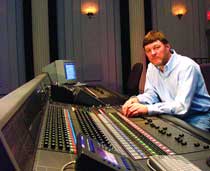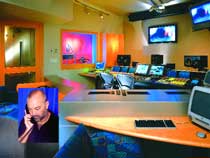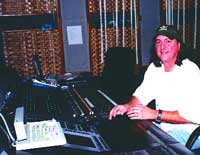The "surround sound is coming" cry has been resounding throughout the post community for years now. It was going to revolutionize how consumers watched television, how mixers would work and even how some programming was recorded. Yet, half a decade later the percentage of shows, or even advertisements for that matter, broadcast in surround is minimal.

David Amlen
|
Those in the pro surround camp point to a number of promising facts. There's the boom in the number of consumers who have bought home theaters to take advantage of 5.1 surround capabilities, the explosion of the DVD market (so much so, that the future of VHS tape is dim) and the ever looming FCC mandate for digital broadcasts by the year 2006.
After all, surround has been the theater standard for the past 10 years and it's sure to spread from the silver screen to the small screen, right?
On the other hand, many post facilities that have already built surround-capable rooms, purchased all the requisite gear and hired experienced mixers only to sit on their hands. The call for surround broadcast is not there, they say, because consumers have not started to demand it. Not only that, the delivery requirements have yet to be finalized, so it's almost like putting the proverbial cart before the horse.

Dolby's, Tom Daily
|
Dolby, one of the leading suppliers of surround technology, is understandably bullish on the state of the surround market. Tom Daily, marketing director, professional audio at Dolby, points out that demand for surround has grown from feature films to television to videogames, and it doesn't look like that demand is going to slow any time soon. "It takes awhile to get the whole infrastructure set up, but we expect to see in the next year or two all the major broadcasters having regular programming with 5.1 and able to accept commercials for 5.1 playback."
Daily has heard from facilities that are still waiting. "I think a lot of [facilities] expected it to be a big new source of income as a way to charge for additional revenue," he says. "Except for the real high-end customers, it hasn't been the cash cow they were hoping for."

Sync Sound's Ken Hahn: "To be able to say that something has a 5.1 mix is a bonus, but [clients] don't necessarily want to pay a lot more for getting it."
|
The good news for mixers, Daily reports, is that moving to 5.1 should be a snap. "As far as the mixing talent, if they have worked with Dolby Surround Pro Logic, the old LCRS to create LTRT, when they move to 5.1 it's not a huge leap in terms of time it takes to mix," he says. "But the bang for it is much more powerful than it ever was with Pro Logic. Creatives can make their presentations much more entertaining and much more involving then they ever could before."
One of the reasons Daily is so bullish on 5.1 is because of the inevitable FCC requirements for digital television and the buzz around local TV stations. "They are getting much more serious about their planning, so what that tells me - for the facilities that are staying state of the art - is that when their local stations can accept higher quality advertisements and higher quality local content, they'll be putting it on the air," he states.
Another reason Daily is looking forward is that many producers of TV series are archiving their shows in 5.1 for the future. "If you're doing something today that people are going to be watching three or five years from now, you definitely want to do a 5.1 mix - even just to put it on the shelf," he says. "Trying to go back three years from now and do that mix when the show comes out in syndication, or when there's a use for it in the future, is going to be a nightmare."
So what do audio post studios think?
Sync Sound
Ken Hahn, co-owner of NYC's Sync Sound (www.syncsound.com), sees good things in the surround market because of the popularity of DVDs and the fact that Sync Sound is delivering some television programs in 5.1 - some for use overseas. Sync Sound first got involved with surround through mixing features and high-end projects, so the company was in early enough where they didn't have to make a huge investment to do 5.1 for television. However, Hahn didn't believe it would take this long for broadcast surround to happen. "We did gear up for things we thought were going to happen sooner and we were really beating the drum," he says. "Inevitably not much happened, but now it's pretty regular. The high-end programs that we do, you don't even have to sell it because someone has already sold them on it."
One of the keys of the work Sync Sound has done in surround is to make sure it's believable, especially for a retrospective show.
"That's become an art in itself, [taking] the audio from 20 to 30 years ago into performance stuff for today and making all that work in a way that people find entertaining, as opposed to distracting," Hahn explains. "If it's black and white footage of this old blues player sitting on a park bench - that's not 5.1. You need the sound to sound like the picture."
So far, Hahn reports, clients still perceive surround work as an additional service and cost, and not yet the standard. "To be able to say that something has a 5.1 mix is a bonus, but they don't necessarily want to pay a lot more for getting it. That's part of the challenge of doing these things. The experience that I've had is that the more involved the client's are, the more they realize what they are getting, and the next time they're more enthusiastic about trying to budget for it."
While the company has done a number of surround projects, Hahn is realistic about the current state of the industry. "Has the revolution happened? By no means. Is it going to happen? I don't know," he says. "For the right programs it works great and for people who are trying to do a dual release, [they may have a limited feature market] it's another value-added for their distribution film, that it's in 5.1 already. It's something that distributors and people who sell these films want to see."
Tonic
Peter Fish, composer and principal at Tonic (www.tonic.tv) in NYC, points out that surround is a growing market in the archival sense. "As a format 5.1 is a reasonably secure format, it's future-proof," he says. "Originally 5.1 was thought of as a companion to high def in terms of posting. Well, high def is a format in flux and so while there's still a lot of unease in high def, now 24p seems to be the way to go - there is no ambivalence about 5.1 as a standard."

"It's cheaper to do [surround] while you're doing your stereo product than it is to figure it out two years down the road," says Peter Fish of Tonic. The studio recently added three Euphonix 5 rooms designed by NYC's Downtown Group.
|
What's actually happening, he adds, is thanks to the advent of the DVD market, 5.1 is essentially a catalog enhancing format.
"So, the archival application - re-configuring old mixes in 5.1, updating mixes to include an enhanced surround elements or new programming for DV titling, or even re-engineering old recordings in a 5.1 in audio CDs - has out paced what I thought the actual need would be," he says. "Still, it's not a major part of our business."
To be ready, Tonic purchased three Euphonix System 5s and in their West Side facility; they also have two Neve Libras. Their smaller rooms are running the 5.1-capable Pro Control 24s with Pro Tools. Fish reports that he was not worried about making such an investment without a steady demand for surround work. "I wouldn't purchase technology simply to do 5.1 but, my business is based on the high end of the market. So, the high end of the market demands this sort of technology for stereo mixes. It's good technology. That it does 5.1 and does it well is just an added plus."
Sound on Sound
The state of surround is quite variable, explains Sound on Sound Recording's president, David Amlen. "If we're talking about feature film, it's the de facto standard. If we're talking about television production, it's dependent on the budget. And if we're talking about music it's a curiosity at this point," he says. The vast majority of the surround work the company has done has been for major label music projects, though somewhere around 96 percent of its business is still stereo. "Surround is not a big percentage of our business yet," Amlen says. "But it's better than zero."
The Sound on Sound (www.soundonsoundstudios.com) believed surround was on its way three years ago when they built Studio C around a Sony Oxford console. "We were definitely a little off," he admits. But he, too, sees a future. "I think as the advertising community rebounds and the dust settles from the slew of post production places that closed in New York this year, you'll see a healthier landscape and more of that kind of work come in."
While they are set up for surround work, there has not been any call for those services. "It's frustrating [because] the manufacturers will lobby you to the point that they believe it's a necessary thing and if you don't have it you're behind the times," Amlen says. "The clients sort of buy into that. So, they ask if we have this or that and you have to say 'yes' or they're not going to come in."
Sound on Sound has gotten around that frustration by being careful about their expenses. "You have to make sure there's enough to keep you afloat," Amlen explains. "I wish there was some easy magic crystal that I could look at, but it is so client driven on every level that to get them in the door you have to have all sorts of things."
The impending surround boom has raised the bar for all television programming, Amlen says. "Television sound has gotten better. Therefore, when you are doing commercials and even industrials, people expect to be able to walk out with that kind of quality."
POP Sound
Things are hopping at Santa Monica's POP Sound (www.popsound.com) when it comes to surround work, says mixer Ted Hall. "I haven't done a stereo mix in five or six years," he reports. "We have commercial stages here and they do a lot of commercial trailers that play in a theater and those are 5.1. And there's a whole department here dedicated to DVD. Without a doubt it's the prominent mix format here at POP."

"I haven't done a stereo mix in five or six years," says POP Sound's Ted Hall, manning his Logic II.
|
As for surround broadcast, Hall thought it was only a year or so away. "But so far they really haven't done that much," he reports.
"ABC has done some stuff and I did a couple shows, like re-conforming and cleaning up the Raiders of the Lost Ark and Indiana Jones and the Temple of Doom that was broadcast in 5.1." The first 5.1 broadcast he did was Birdcage for the network five years ago.
POP got ready for surround eight years ago when the company purchased an AMS Neve Logic II console. "It was designed for film but actually works great for general post because you're able to monitor 5.1, Dolby Matrix, surround, stereo and mono all at the flick of a switch," Hall explains. "As soon as I got the console we were working. The first year, we mixed NYPD Blue and Chicago Hope to be broadcast in regular Dolby Surround."
Hall recently finished working on a 5.1 remix for the classic Serpico.
Sound Lounge
"We made a big deal about being surround ready when we opened four years ago, and we've done two sessions for surround," says Tom Jucarone, co-owner/mixer at NYC's Sound Lounge (www.soundlounge.com). "And both of them were not for TV. They were for special situations," he adds. "I keep asking people if they want to do a surround mix for their commercials and nobody is into it," he explains.
One of the problems he sees so far is that there's no good way to broadcast a surround mix. "Am I in love with the 5.1 surround? I am for movies and I hope to be when we get into doing commercials," he says, "but, especially for a small TV, sometimes it detracts from your message. It's too big."
Even though Sound Lounge has yet to see much business in the surround market the company is keeping up with technology. "We're opening three new studios and they are all equipped to do the EX stuff," Jucarone says. "We want to be prepared in case somebody wants to do it. When we opened, I got a Harrison console because I knew they did consoles for large movie mixing companies and they knew how to do all these different formats. So, I've had this console for four years that can do 7.1 and anything I want to do with it and I'm doing stereo mixes on it."
Yet, making that purchase did not cause him concern. "It's still fun," Jucarone says. "We still do mixes for our own thing because you have to keep learning. You have to have some kind of experience with it, and we're just waiting for that transition that everybody keeps promising."
As for a timeframe, Jucarone puts it on the consumers and the broadcasters. "Right now, you can't broadcast 5.1. Nobody has a receiver to pick it up."
While Jucarone loves watching movies in 5.1, he's still not sold on its broadcast merits. "I'm probably one of the few people that you'll talk to that won't laud all the aspects of 5.1, because it is what it is."